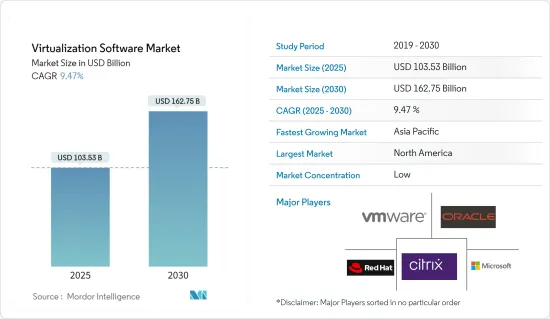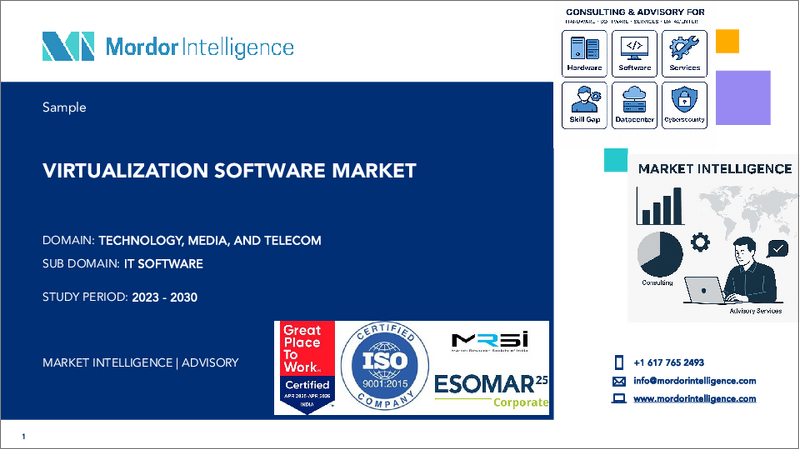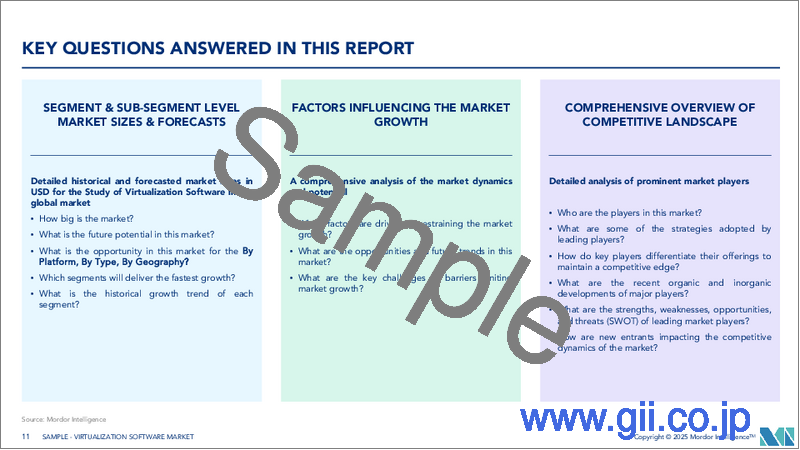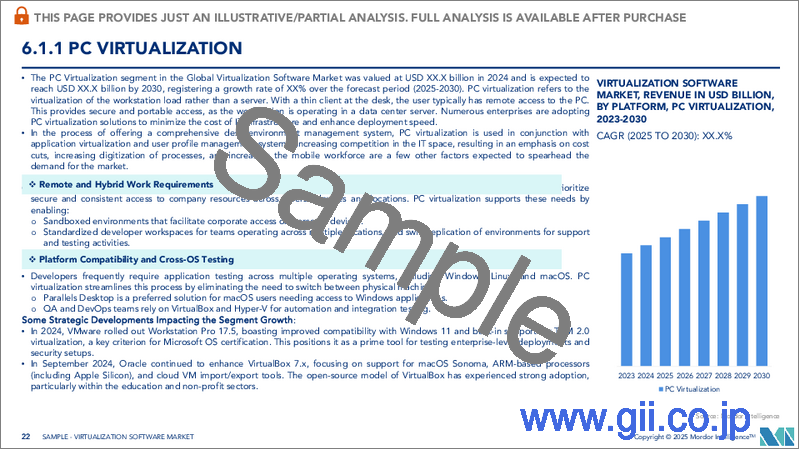|
|
市場調査レポート
商品コード
1641999
仮想化ソフトウェア:市場シェア分析、産業動向・統計、成長予測(2025年~2030年)Virtualization Software - Market Share Analysis, Industry Trends & Statistics, Growth Forecasts (2025 - 2030) |
||||||
カスタマイズ可能
適宜更新あり
|
|||||||
| 仮想化ソフトウェア:市場シェア分析、産業動向・統計、成長予測(2025年~2030年) |
|
出版日: 2025年01月05日
発行: Mordor Intelligence
ページ情報: 英文 120 Pages
納期: 2~3営業日
|
全表示
- 概要
- 目次
仮想化ソフトウェアの市場規模は2025年に1,035億3,000万米ドルと推定され、予測期間(2025~2030年)のCAGRは9.47%で、2030年には1,627億5,000万米ドルに達すると予測されます。

仮想化ソフトウェア市場は、最新のITインフラストラクチャの極めて重要なコンポーネントであり、企業によるリソース利用の最適化、管理プロセスの合理化、運用コストの削減を可能にします。仮想化ソフトウェアはハードウェア・システムを抽象化し、複数の仮想環境を単一の物理マシン上で動作させることができます。このようにハードウェアとソフトウェアを切り離すことで、物理コンピュータをエミュレートする仮想マシン(VM)の作成が容易になり、サーバ仮想化、クラウド・コンピューティング、ディザスタ・リカバリなどのアプリケーションの柔軟性が高まります。計算需要の増加に対応するため、データセンター仮想化やクラウドベースのサービスを採用する企業が増えており、仮想化ソフトウェア市場は拡大を続けています。
主なハイライト
- 仮想化による効率化:仮想化技術は大幅な効率化を実現するため、IT部門はリソースを迅速に配備し、必要に応じてインフラを拡張できます。また、集中管理や仮想化セキュリティの強化といったメリットもあります。オープンソースの仮想化ソフトウェアはコスト効率の高いソリューションを提供し、プロプライエタリなプラットフォームは包括的な機能と専用サポートを提供します。しかし、仮想化の導入を成功させるには、特に複雑な環境では、セットアップや構成に専門的な知識が必要になることが多いです。
- 業界の主要プレイヤーVMware、Microsoft、Citrix Systems、Oracleなどの大手企業が、この分野の技術革新をリードしています。これらの企業は、サーバー仮想化、ネットワーク仮想化、デスクトップ仮想化、クラウドネイティブ仮想化をサポートする仮想化プラットフォームの開発に注力しています。競争力を維持するため、これらの市場リーダーはハイパーバイザー技術の強化、自動化の改善、堅牢なセキュリティ機能の統合に投資しています。
仮想化によるITインフラ最適化
主なハイライト
- コスト削減:仮想化は、ハードウェアの追加を最小限に抑えることで、運用コストの削減に貢献します。サーバ仮想化では、1台のサーバ上で複数の仮想マシンが実行されるため、ハードウェアの利用率が最適化され、物理サーバの購入と維持に伴うコストが削減されます。
- ハードウェアの節約:従来のIT環境では、オペレーティング・システムごとに物理サーバを用意する必要があり、ハードウェアが十分に活用されていませんでした。これらのシステムを仮想化することで、企業はより高いサーバー利用率を達成し、必要な物理マシンの総数を減らすことができます。これにより、ハードウェアへの資本支出が削減され、エネルギー消費量も減少します。
- 拡張性:仮想化ソフトウェアは、ITインフラの迅速な拡張を可能にします。企業は、ダウンタイムを最小限に抑えながら、仮想マシンを迅速に作成、クローン化、移行できるため、クラウド環境やハイパフォーマンス・コンピューティング・シナリオにおける需要の変動に対応できます。
- エネルギー効率:物理サーバーを統合することで、電源や冷却に必要なエネルギーが削減され、データセンターのエネルギー効率が向上します。これにより、運用コストを削減できるだけでなく、組織の二酸化炭素排出量を削減することで、企業の持続可能性への取り組みも支援します。
仮想化によるITオペレーションの合理化
仮想化テクノロジーは、チームが仮想環境を一元管理できるようにすることで、IT管理を劇的に簡素化します。単一のプラットフォームで仮想マシンを迅速に導入し、問題をトラブルシューティングできるため、運用効率が向上します。
主なハイライト
- 集中管理:仮想化プラットフォームが提供する集中管理により、仮想マシンの管理が簡素化されます。IT管理者は、単一のインターフェイスから複数の仮想環境を導入、更新、管理できるため、複雑さが軽減され、メンテナンスに費やす時間を最小限に抑えることができます。
- ディザスタリカバリ:仮想化ソリューションは、ディザスタリカバリ戦略を強化します。仮想マシンのバックアップとリストアが容易に行えるため、システム障害時の復旧時間が大幅に短縮されます。さらに、多くの仮想化プラットフォームにディザスタリカバリツールが組み込まれているため、サードパーティのソリューションへの依存度が低くなります。
- セキュリティの強化:仮想化によって仮想マシンを分離できるため、セキュリティ侵害のリスクが低減します。役割ベースのアクセス制御、暗号化、安全な移行などの仮想化セキュリティ機能により、企業は機密データを保護し、潜在的な攻撃の影響を抑えることができます。
仮想化ソフトウェア市場の動向
PC/デスクトップ仮想化が大きなシェアを占める見込み
- スケーラブルで効率的なITソリューションへの需要が高まる中、仮想化ソフトウェア市場は急速に拡大しています。ハードウェアやストレージ・デバイスの仮想バージョンを作成できる仮想化技術は、コストを削減しながらリソースの利用率を高める。クラウド・コンピューティング、データセンターの仮想化、ハイパーバイザー技術の進歩は、この市場の主要促進要因です。いくつかの注目すべき動向が、仮想化ソフトウェアの将来を形成しています。
- リモートワークがVDI採用を後押し:リモートワークへのシフトが、仮想デスクトップ・インフラ(VDI)の採用を後押ししています。VDIは、企業が中央サーバーからデスクトップ環境を安全に展開することを可能にします。これにより、従業員の所在地に関係なくシームレスなパフォーマンスを実現するとともに、ハードウェア・コストを削減できます。
- アプリケーション仮想化の成長:企業が互換性の問題を最小限に抑え、レガシー・システムを保護しようとする中、アプリケーションの仮想化が人気を集めています。この技術により、アプリケーションは基盤となるオペレーティング・システムから独立して実行できるようになり、リスクが軽減され、互換性が強化されます。
- オープンソース・ソフトウェアの拡大:KVMやXenなど、費用対効果の高いオープンソースの仮想化プラットフォームが、特に中小企業の間で人気を集めています。これらのプラットフォームは強力な仮想マシン管理ツールを提供し、高額なライセンシング・コストを負担することなくシステムを最適化できます。
- セキュリティの重視:クラウド仮想化やハイブリッドITの台頭により、仮想環境のセキュリティ確保が優先課題となっています。仮想マシンとハイパーバイザー層を保護する必要性から、高度なセキュリティ・ソリューションに対する需要が高まり、PC/デスクトップ仮想化が市場の支配的な地位を維持しています。
アジア太平洋地域が最大の市場規模を記録する見込み
- アジア太平洋地域は、急速な産業化、ITインフラ投資の拡大、クラウドコンピューティングの採用増加により、仮想化ソフトウェア市場を独占すると予想されます。特に通信やBFSI(銀行、金融サービス、保険)などの業界では、中国、インド、日本などの国々がこのデジタル変革の先頭に立っています。
- クラウド仮想化の成長:この地域の企業は、リソースの効率化とITコストの削減を目的に、クラウド仮想化を急速に導入しています。企業が従来のハードウェアから仮想化環境へ移行するのに伴い、クラウドサービスへの需要が市場の堅調な拡大を牽引しています。
- 中小企業向けオープンソース・ソリューション:中小企業は、そのコスト効率と柔軟性から、オープンソースの仮想化ソフトウェアを採用する傾向が強まっています。この傾向は、インドのような国々でデジタルインフラを推進する政府のイニシアティブによって後押しされ、手頃な価格でスケーラブルな仮想化ソリューションに対する需要の高まりにつながっています。
- コンテナ化の動向:この地域では、コンテナ化技術の台頭も見られます。コンテナ化技術は、従来の仮想化と比較して、クラウドネイティブなアプリケーションの効率化を実現します。このシフトは、仮想化とコンテナ化の両方の利点を融合させたハイブリッド環境とマルチクラウド環境の成長を支えています。
仮想化ソフトウェア業界の概要
仮想化ソフトウェア市場は非常に細分化されており、大手企業とニッチプレーヤーが市場シェアを争っています。VMware、Microsoft、Oracle、Citrixなどの企業は、サーバー仮想化、ネットワーク仮想化、デスクトップ仮想化など、さまざまな分野で包括的な仮想化ソリューションを提供し、世界の優位を占めています。
主な業界リーダーVMwareは、データセンター仮想化のための幅広いソリューションで市場をリードしています。マイクロソフトのHyper-Vプラットフォームは、同社のクラウドサービスにおける強力なポジションを活用しており、オラクルとシトリックスは高度な統合仮想化ソリューションの提供に注力しています。
今後の成長に向けた新たな動向:クラウドネイティブ仮想化やコンテナ化のような動向が浸透するにつれ、市場はより俊敏でスケーラブルなソリューションへとシフトしています。企業は競争力を維持するために、クラウド統合、セキュリティ強化、マルチクラウド環境のサポートに投資する必要があります。また、エッジコンピューティングのような新たなテクノロジーも、このダイナミックな業界の将来を形作る上で重要な役割を果たすと思われます。
その他の特典:
- エクセル形式の市場予測(ME)シート
- 3ヶ月間のアナリストサポート
目次
第1章 イントロダクション
- 調査の前提条件と市場定義
- 調査範囲
第2章 調査手法
第3章 エグゼクティブサマリー
第4章 市場洞察
- 市場概要
- 業界の魅力度-ポーターのファイブフォース分析
- 供給企業の交渉力
- 消費者の交渉力
- 新規参入業者の脅威
- 競争企業間の敵対関係
- 代替品の脅威
- COVID-19の業界への影響評価
第5章 市場力学
- 市場促進要因
- ハードウェア支出削減によるコスト削減
- 仮想化によるIT効率の向上
- 市場の課題
- 仮想環境構築の複雑さ
第6章 市場セグメンテーション
- プラットフォーム別
- PC仮想化
- モバイル仮想化
- タイプ別
- アプリケーション仮想化
- ネットワーク仮想化
- ハードウェア仮想化
- その他のタイプ
- 地域別
- 北米
- 欧州
- アジア
- オーストラリア・ニュージーランド
- ラテンアメリカ
- 中東・アフリカ
第7章 競合情勢
- 企業プロファイル
- VMware Inc
- Citrix Systems Inc.
- Oracle Corporation
- Microsoft Corporation
- Red Hat Inc.(IBM Corporation)
- Amazon Inc.
- Google LLC.
- NComupting Co. Ltd.
- Parallels International GmbH
- Huawei Technologies Co. Ltd.
- Datadog, Inc.
- Nutanix Inc.
- TenAsys Corporation
- Lynx Software Technologies
第8章 投資分析
第9章 市場機会と今後の動向
The Virtualization Software Market size is estimated at USD 103.53 billion in 2025, and is expected to reach USD 162.75 billion by 2030, at a CAGR of 9.47% during the forecast period (2025-2030).

The virtualization software market is a pivotal component of modern IT infrastructure, enabling businesses to optimize resource utilization, streamline management processes, and reduce operational costs. Virtualization software abstracts hardware systems, allowing multiple virtual environments to operate on a single physical machine. This decoupling of hardware from software facilitates the creation of virtual machines (VMs), which emulate physical computers, enhancing flexibility for applications such as server virtualization, cloud computing, and disaster recovery. As organizations increasingly adopt data center virtualization and cloud-based services to meet rising computational demands, the virtualization software market continues to expand.
Key Highlights
- Efficiency through Virtualization: Virtualization technologies offer significant efficiency improvements, enabling IT departments to deploy resources quickly and scale infrastructure as needed. Businesses benefit from centralized management and enhanced virtualization security. Open-source virtualization software provides cost-effective solutions, while proprietary platforms offer comprehensive features and dedicated support. However, successful implementation of virtualization often requires specialized expertise for setup and configuration, particularly in complex environments.
- Key Industry Players: Major players such as VMware, Microsoft, Citrix Systems, and Oracle are leading innovation in this field. These companies are focused on developing virtualization platforms that support server virtualization, network virtualization, desktop virtualization, and cloud-native virtualization. To stay competitive, these market leaders invest in enhancing hypervisor technology, improving automation, and integrating robust security features.
IT Infrastructure Optimization through Virtualization
Key Highlights
- Cost Reduction: Virtualization helps businesses reduce operational expenses by minimizing the need for additional hardware. With server virtualization, multiple virtual machines run on a single server, optimizing hardware utilization and cutting costs associated with purchasing and maintaining physical servers.
- Hardware Savings: Traditional IT environments require separate physical servers for different operating systems, leading to hardware underutilization. By virtualizing these systems, companies achieve higher server utilization rates, reducing the overall number of physical machines required. This contributes to reduced capital expenditures on hardware and lower energy consumption.
- Scalability: Virtualization software enables rapid scaling of IT infrastructure. Businesses can quickly create, clone, or migrate virtual machines with minimal downtime, allowing them to respond to fluctuating demand in cloud environments or high-performance computing scenarios.
- Energy Efficiency: Consolidating physical servers leads to fewer energy requirements for power and cooling, enhancing the energy efficiency of data centers. This not only lowers operational costs but also supports corporate sustainability efforts by reducing the organization's carbon footprint.
Streamlining IT Operations with Virtualization
Virtualization technology dramatically simplifies IT management by allowing teams to centrally manage virtual environments. The ability to deploy virtual machines quickly and troubleshoot issues through a single platform enhances operational efficiency.
Key Highlights
- Centralized Management: Virtual machine management is simplified through centralized control offered by virtualization platforms. IT administrators can deploy, update, and manage multiple virtual environments from a single interface, reducing complexity and minimizing the time spent on maintenance.
- Disaster Recovery: Virtualization solutions enhance disaster recovery strategies. Virtual machines can be easily backed up and restored, significantly improving recovery times in case of system failure. Moreover, many virtualization platforms incorporate disaster recovery tools, reducing reliance on third-party solutions.
- Enhanced Security: Virtualization enables the isolation of virtual machines, reducing the risk of security breaches. With virtualization security features like role-based access control, encryption, and secure migration, businesses can safeguard sensitive data and limit the impact of potential attacks.
Virtualization Software Market Trends
PC/ Desktop Virtualization is Expected to hold Major Market share
- As the demand for scalable and efficient IT solutions grows, the virtualization software market is expanding rapidly. Virtualization technology, which enables the creation of virtual versions of hardware and storage devices, boosts resource utilization while cutting costs. Cloud computing, data center virtualization, and advancements in hypervisor technology are key drivers of this market. Several notable trends are shaping the future of virtualization software.
- Remote Work Boosting VDI Adoption: The shift to remote work has driven adoption of virtual desktop infrastructure (VDI), which enables businesses to securely deploy desktop environments from central servers. This ensures seamless performance regardless of the employee's location while reducing hardware costs.
- Application Virtualization Growth: As companies look to minimize compatibility issues and secure legacy systems, application virtualization is gaining traction. This technology allows applications to run independently from the underlying operating system, reducing risks and enhancing compatibility.
- Open-Source Software Expansion: Cost-effective open-source virtualization platforms such as KVM and Xen are gaining popularity, particularly among SMEs. These platforms provide powerful virtual machine management tools, helping businesses optimize their systems without incurring high licensing costs.
- Focus on Security: With the rise of cloud virtualization and hybrid IT setups, securing virtual environments has become a priority. The need to protect virtual machines and hypervisor layers drives demand for advanced security solutions, ensuring PC/desktop virtualization remains a dominant force in the market.
Asia Pacific is Expected to Register the Largest Market
- The Asia-Pacific region is expected to dominate the virtualization software market due to rapid industrialization, growing IT infrastructure investments, and the increasing adoption of cloud computing. Countries such as China, India, and Japan are spearheading this digital transformation, especially within industries like telecommunications and BFSI (Banking, Financial Services, and Insurance).
- Cloud Virtualization Growth: Businesses in the region are rapidly adopting cloud virtualization to enhance resource efficiency and cut IT costs. As companies shift from traditional hardware to virtualized environments, the demand for cloud services is driving robust market expansion.
- Open-Source Solutions for SMEs: Small and medium-sized enterprises (SMEs) are increasingly adopting open-source virtualization software due to its cost-efficiency and flexibility. This trend is bolstered by government initiatives to promote digital infrastructure in countries like India, leading to a higher demand for affordable, scalable virtualization solutions.
- Containerization Trends: The region is also witnessing a rise in containerization technologies, which offer more efficiency for cloud-native applications compared to traditional virtualization. This shift supports the growth of hybrid and multi-cloud environments, blending the benefits of both virtualization and containerization.
Virtualization Software Industry Overview
The virtualization software market is highly fragmented, with major corporations and niche players competing for market share. Companies like VMware, Microsoft, Oracle, and Citrix dominate the global landscape by offering comprehensive virtualization solutions across various sectors, including server virtualization, network virtualization, and desktop virtualization.
Key Industry Leaders: VMware remains a market leader with a wide range of solutions for data center virtualization. Microsoft's Hyper-V platform leverages the company's strong position in cloud services, while Oracle and Citrix focus on providing advanced, integrated virtualization solutions.
Emerging Trends for Future Growth: As trends like cloud-native virtualization and containerization gain traction, the market is shifting toward more agile and scalable solutions. Companies must invest in cloud integration, enhanced security, and support for multi-cloud environments to stay competitive. Emerging technologies like edge computing will also play a crucial role in shaping the future of this dynamic industry.
Additional Benefits:
- The market estimate (ME) sheet in Excel format
- 3 months of analyst support
TABLE OF CONTENTS
1 INTRODUCTION
- 1.1 Study Assumptions and Market Definition
- 1.2 Scope of the Study
2 RESEARCH METHODOLOGY
3 EXECUTIVE SUMMARY
4 MARKET INSIGHTS
- 4.1 Market Overview
- 4.2 Industry Attractiveness - Porter's Five Forces Analysis
- 4.2.1 Bargaining Power of Suppliers
- 4.2.2 Bargaining Power of Consumers
- 4.2.3 Threat of New Entrants
- 4.2.4 Intensity of Competitive Rivalry
- 4.2.5 Threat of Substitutes
- 4.3 Assessment of Impact Of Covid-19 on the Industry
5 MARKET DYNAMICS
- 5.1 Market Drivers
- 5.1.1 Cost Reductions due to Reduced Hardware Spending
- 5.1.2 Improved IT Efficiency due to Virtualization
- 5.2 Market Challenges
- 5.2.1 Complexity in Setting up a Virtual Environment
6 MARKET SEGMENTATION
- 6.1 By Platform
- 6.1.1 PC Virtualization
- 6.1.2 Mobile Virtualization
- 6.2 By Type
- 6.2.1 Application Virtualization
- 6.2.2 Network Virtualization
- 6.2.3 Hardware Virtualization
- 6.2.4 Other Types
- 6.3 By Geography
- 6.3.1 North America
- 6.3.2 Europe
- 6.3.3 Asia
- 6.3.4 Australia and New Zealand
- 6.3.5 Latin America
- 6.3.6 Middle East and Africa
7 COMPETITIVE LANDSCAPE
- 7.1 Company Profiles
- 7.1.1 VMware Inc
- 7.1.2 Citrix Systems Inc.
- 7.1.3 Oracle Corporation
- 7.1.4 Microsoft Corporation
- 7.1.5 Red Hat Inc. (IBM Corporation)
- 7.1.6 Amazon Inc.
- 7.1.7 Google LLC.
- 7.1.8 NComupting Co. Ltd.
- 7.1.9 Parallels International GmbH
- 7.1.10 Huawei Technologies Co. Ltd.
- 7.1.11 Datadog, Inc.
- 7.1.12 Nutanix Inc.
- 7.1.13 TenAsys Corporation
- 7.1.14 Lynx Software Technologies






